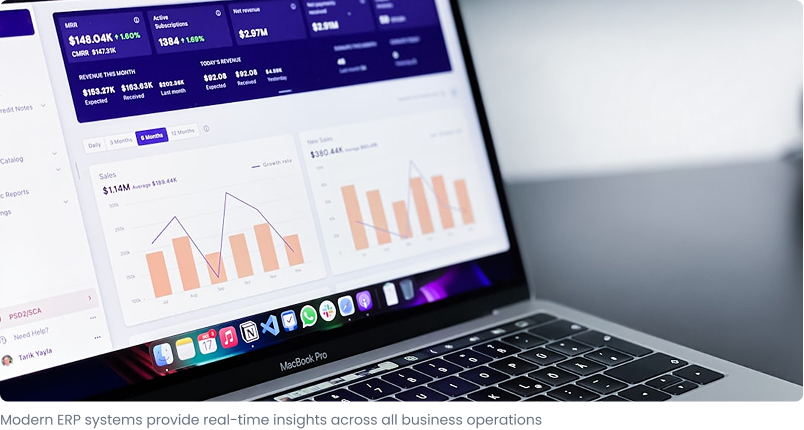Israr Ahmed
May 07, 2025 • 5 min read

Learn what an ERP system is, how it works, key modules, benefits, and deployment types. A practical guide for businesses planning to scale and streamline operations.
ERP (Enterprise Resource Planning) is a software that integrates and manages core business processes like accounting, procurement, project management, compliance, and supply chain operations. A complete ERP System includes tools for planning, budgeting, and financial reporting. ERP connects departments like HR, finance, and manufacturing, automating data flow between them, eliminating silos, and ensuring synchronization. By providing a unified view of the business, ERP helps make informed decisions and boosts efficiency.
 Manual data entry across platforms
Manual data entry across platforms Duplicate information
Duplicate information Inconsistent reporting
Inconsistent reporting Delayed insights
Delayed insights Single source of truth
Single source of truth Automated workflows
Automated workflows Consistent data across departments
Consistent data across departments Real-time insights
Real-time insightsERP systems are made up of different parts, called modules. Each module handles a specific area of the business, but they all work together and share the same information. This makes it easier to manage everything in one place.
Here are the most common ERP modules:
Pro Tip
By using these modules together, your whole business stays connected. Everyone works from the same up-to-date information, which saves time and reduces mistakes.
Enterprise Resource Planning (ERP) is a unified system that connects all the major functions of a business—finance, human resources, inventory, procurement, customer management, and more—into one integrated platform. Instead of having different departments use separate tools or manual processes, an ERP system allows the entire organization to work from a centralized source of information.
This integration brings consistency, accuracy, and real-time visibility into operations. For instance, when a sale is recorded, the system automatically updates inventory, generates an invoice, adjusts accounting entries, and reflects the impact on cash flow. This seamless automation replaces siloed processes, reduces errors, and saves time.
Example:
A construction company uses ERP to manage building materials, employee payroll, contractor schedules, and budgeting — all in one place.
ERP systems are built on a central database with defined data structures. Each module—whether it’s HR, accounting, inventory, or procurement—pulls and updates information from this central repository. This ensures that everyone across the organization is working with the same data, in real time.
Here’s what ERP enables at a foundational level:
Imagine a company offering IT services with teams handling client onboarding, support tickets, billing, and staffing. Without ERP, each function might rely on separate spreadsheets, tools, or communication chains—making it difficult to track the customer journey or identify bottlenecks.
With ERP in place:
The result? Everyone works more efficiently, and leadership gains a 360-degree view of business performance.
In today’s fast-moving environment, businesses need reliable systems that reduce manual effort and enhance decision-making. ERP delivers this by:
Whether you're running a manufacturing unit, a retail business, or a real estate firm, ERP is the digital foundation that brings order, structure, and insight into your operations.
The value of an ERP system is in its ability to integrate and automate core business functions. Here are some of the benefits it offers:
The core difference between ERP (Enterprise Resource Planning) and CRM (Customer Relationship Management) lies in their focus within a business:
ERP systems can be deployed in different ways depending on a company’s needs, size, and technical capabilities. Here are the three main types:
This is the traditional method. The ERP software is installed on your own servers and managed by your in-house IT team. It offers full control over your system and data but requires a bigger upfront investment in hardware and IT support.
Best for: Companies with strict data control needs or strong internal IT resources.
This type of ERP runs on the vendor’s servers and is accessed via the internet. It’s usually subscription-based (SaaS), easier to set up, and maintained by the provider—so your team doesn’t have to worry about updates, security, or infrastructure.
Best for: Small to mid-sized businesses or companies wanting low maintenance and easy scalability.
A mix of both on-premise and cloud. Some modules run in the cloud while others stay on your servers. This setup offers flexibility—letting businesses keep sensitive operations in-house while using cloud benefits for other functions.
Best for: Organizations with specific security needs or those transitioning to the cloud gradually.
Not every business may start with an ERP, but certain signs make it clear when it's time:
Data is scattered across multiple systems.
Difficulty in accessing real-time information.
Manual and repetitive processes consume too much time.
Inaccurate inventory or financial reporting.
Poor interdepartmental communication.
Rapid business growth or scaling plans.
An ERP system offers numerous benefits that can significantly transform your business operations. By consolidating key business functions into one unified platform, ERP enables more efficient processes, better decision-making, and improved collaboration. Below are some of the most impactful benefits:
Streamlined Operations
Real-Time Data Access
Improved Collaboration Across Departments
Better Decision-Making
Cost Reduction
Scalability for Growth
Enhanced Customer Service
Compliance and Risk Management
Optimized Inventory Management
Financial Management and Control
Boosted Productivity
An ERP system is no longer just a tool for large enterprises; it's a vital asset for businesses of all sizes, including small and mid-sized companies, looking to stay competitive and prepared for the future. With customizable ERP solutions from SA Systems, you can tailor the system to your unique operational needs, selecting only the modules that align with your business goals and growth strategy.
Israr Ahmed
ERP Solutions Specialist at SA Systems
Israr specializes in digital transformation strategies for mid‑sized enterprises.
 ERP
ERPMarch 15, 2025
 ERP
ERPFebruary 28, 2025
.png) ERP
ERPJanuary 20, 2025
.png) Real Estate
Real EstateDecember 10, 2024